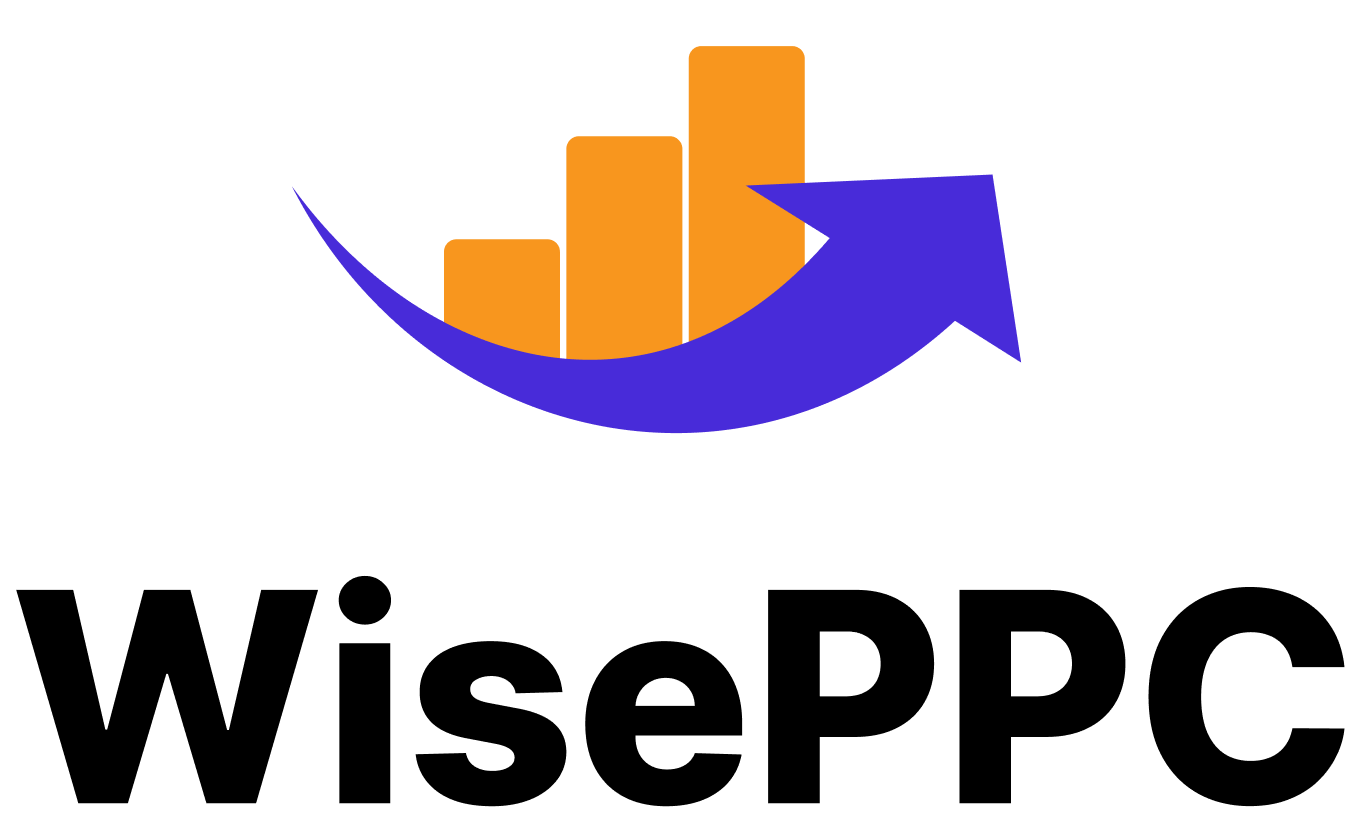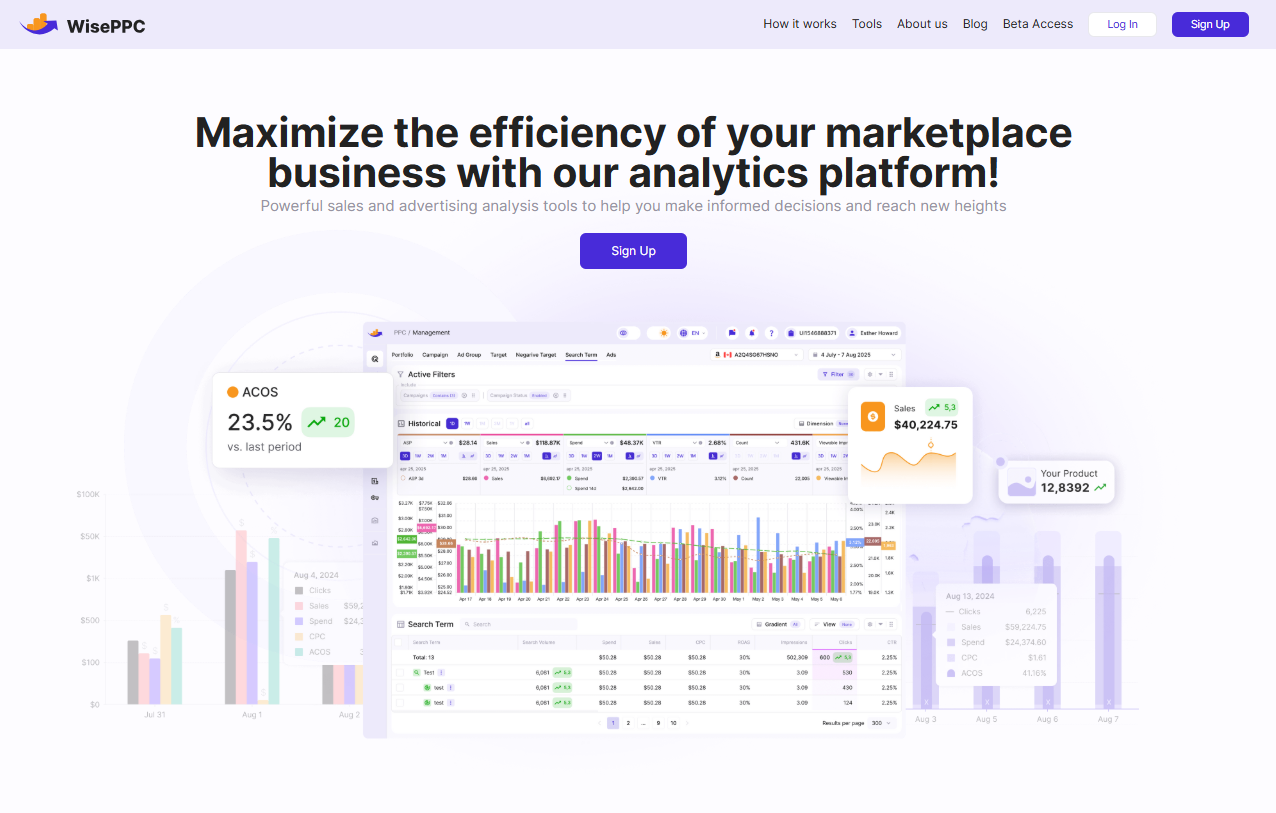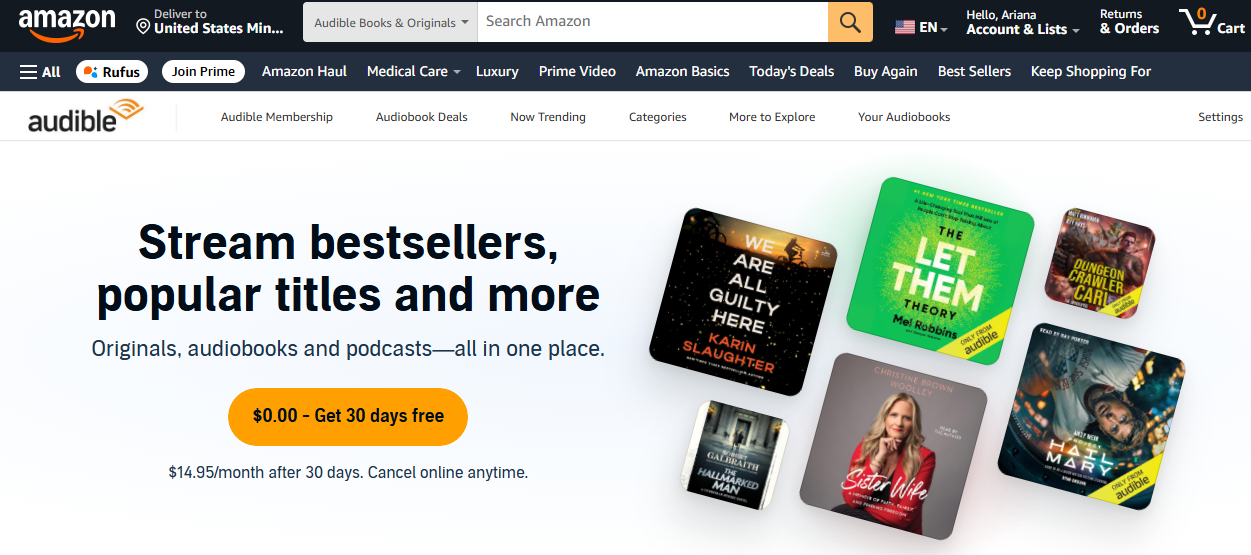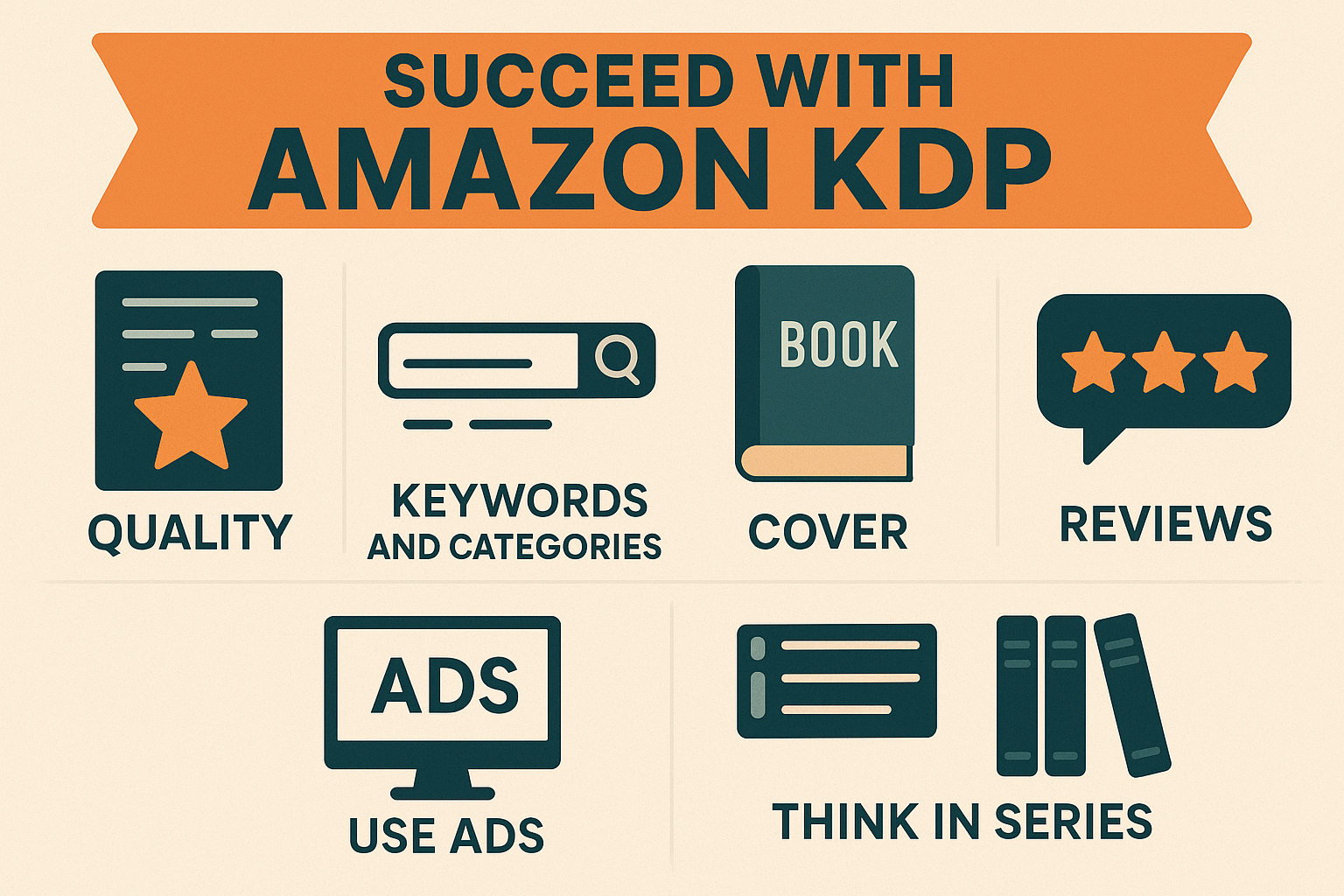What Is Amazon KDP? A Simple Guide for First-Time Authors
You’ve probably seen Kindle books while browsing Amazon. What you might not realize is that a huge chunk of those titles weren’t published by traditional publishers, they were uploaded by everyday writers using Amazon KDP. Amazon Kindle Direct Publishing (KDP) has completely changed the way books are published. You don’t need a book deal, an agent, or a warehouse full of printed copies. If you’ve written a manuscript, you can turn it into a live product on Amazon: digital, print, or both, in a matter of days. But what exactly is Amazon KDP? How does it work, and is it actually worth using in 2025? That’s what we’ll break down in this article, with zero jargon and no fluff, just the stuff real authors care about.
What Is Amazon KDP?
Amazon KDP stands for Kindle Direct Publishing. It’s Amazon’s self-publishing platform that lets you upload, publish, and sell your books in digital (Kindle) and paperback formats. With KDP, you’re not asking anyone for permission. You can publish your work for free, set your own price, and reach readers across the globe.
Unlike traditional publishing, you don’t need an agent or publisher. You handle everything yourself or with freelancers you hire. Amazon provides the tools, and you bring the content.
How Does It Work?
The process is surprisingly simple and beginner-friendly. Here’s a step-by-step breakdown:
- Create a free KDP account using your existing Amazon login or sign up with a new email.
- Upload your manuscript in a compatible format like .docx, PDF, ePub, or a Kindle-ready file. Make sure it’s properly formatted for digital or print reading.
- Design a book cover, either by using Amazon’s free cover creator or uploading your own professionally designed artwork.
- Enter all your book details – this includes the title, subtitle (if any), author name, a compelling book description, keywords for search visibility, and relevant categories to help readers find your book.
- Choose your pricing and royalty plan. You can opt for 35% or 70% royalty rates depending on your ebook price and distribution preferences.
- Preview and publish. Double-check everything using Amazon’s preview tools, then hit publish.
Once your book is submitted, Amazon reviews the file and metadata to ensure everything meets its guidelines. This usually takes between 24 and 72 hours. When approved, your book goes live on the Kindle Store. Readers can start buying your ebook, ordering print copies, and leaving reviews.
Amazon takes care of listing your book, delivering digital downloads or printed versions, handling customer service, and providing you with a dashboard to monitor sales and earnings in real time.
Who Can Use KDP?
Anyone. That’s kind of the point.
You don’t need to be a professional writer or have any publishing background. Many authors are first-timers, and some are simply publishing journals, planners, or children’s books with illustrations. As long as you own the rights to the content, you’re good to go.
Students, bloggers, coaches, freelancers, and even retirees use KDP to turn their knowledge or stories into passive income.
Using Tools Like WisePPC to Go Beyond the Basics
If you’re ready to go beyond just uploading your book and hoping for the best, we built WisePPC to help you do exactly that. As an Amazon Ads Verified Partner, we work with self-publishers who want to make smarter, faster, and more informed decisions about how they advertise their books and grow their sales.
We know that Amazon’s native ad reports only show you a short slice of the picture, usually just 60 to 90 days. That’s not enough to understand seasonality, test long-term ad strategies, or optimize across multiple titles. With WisePPC, you get historical data that sticks around, flexible tools to dig into your performance, and clear visuals that make your ad metrics easier to act on.
How We Help Authors Using Amazon KDP
- Track over 30 metrics, including TACOS, ACOS, CTR, and profit, in real time
- Compare ad performance across books, campaigns, and keywords with customizable charts
- Use bulk editing tools to make large-scale updates in just a few clicks
- Segment data by bid strategy, placement, match type, or campaign type to see what really works
- Identify wasted spend and underperforming targets with gradient-based performance highlighting
- Keep historical records indefinitely, even if Amazon deletes them from Seller Central
We designed WisePPC so that even if you’re managing ten books or just one, you can see exactly what’s driving results and where to optimize. Whether you’re running Amazon ads for the first time or fine-tuning a full book funnel, we’re here to help you scale with clarity and confidence.
WisePPC is a verified Amazon Ads partner that offers advanced analytics, campaign optimization tools, and long-term performance tracking. While Amazon’s native reporting only covers a 60- to 90-day window, WisePPC keeps your campaign data indefinitely, helping you make decisions based on long-term trends, not guesswork.
Why So Many People Use Amazon KDP
Amazon dominates the ebook market, controlling more than two-thirds of it. That means your book instantly becomes available to millions of Kindle users. But it’s not just the reach.
Here’s why so many authors choose it:
- Free publishing with no upfront cost: You don’t pay to list your book. Amazon only takes a cut after you make a sale.
- Global distribution: Your ebook or paperback can be purchased in dozens of countries. You don’t need to manage regional stores or separate listings.
- High royalties: You can earn up to 70% on ebooks priced between $2.99 and $9.99. That’s significantly more than many traditional publishing deals.
- Print-on-demand for paperbacks: No inventory required. When someone buys your print book, Amazon prints and ships it automatically.
- Real-time analytics: You get a live dashboard to track royalties, page reads (if you’re in Kindle Unlimited), and overall performance.
- Update your book anytime: Spotted a typo? Need to rework your description? Want to change the price? No need to go through a publisher or wait weeks. You can edit and republish with just a few clicks.
In short, Amazon KDP gives authors the tools and reach of a massive platform while keeping control firmly in their hands. That mix of autonomy, visibility, and low barrier to entry is a big part of why KDP remains the go-to choice for so many first-time (and repeat) authors.
What Can You Publish?
One of the things that makes Amazon KDP so appealing is the flexibility in what you can publish. As long as your content follows Amazon’s publishing guidelines, you’re free to explore just about any genre or format. Fiction is a big one, with authors releasing everything from romance and science fiction to thrillers, fantasy, and historical stories. Nonfiction also does well, especially in areas like business, self-help, health, and cookbooks.
Children’s books and educational materials are also widely published through KDP, often with colorful illustrations and simple layouts that work well on both Kindle and in print. Then there’s the low-content category, which includes journals, planners, notebooks, and even coloring books. These are especially popular among first-time KDP publishers because they don’t require extensive writing, yet still offer strong earning potential if done right.
The beauty of KDP is that it gives you room to experiment. Whether you want to publish a full-length novel, a short how-to guide, or a series of themed notebooks, the platform is open to all of it.
How Much Can You Make (and What Will It Cost You)?
This is the question everyone asks. And the answer is: it depends. Some authors barely break even. Others make thousands each month. A lot rides on the niche you’re in, the quality of your writing and presentation, how well you market your book, your keyword strategy, and how many titles you publish.
If you price your ebook between $2.99 and $9.99, Amazon lets you earn up to 70% in royalties. For paperbacks, the royalty rate is 60%, minus the cost of printing. Payments are made monthly, roughly 60 days after the end of the month when the sale occurs.
Now, let’s talk costs. Publishing on KDP is technically free, but realistically, there are a few things you’ll probably want to invest in:
- Editing: Grammar, clarity, and overall flow matter
- Cover design: Like it or not, people judge books by their covers
- Formatting: Getting your file Kindle-ready and print-friendly
- Marketing: Whether that’s Amazon ads, promo platforms, or social media tools
You can try handling some of these yourself, but many authors find that outsourcing leads to a better product and saves a lot of time. It’s about finding the right balance between budget, quality, and your own skillset.
What About the Competition?
Let’s be honest, Amazon KDP is a busy place. Thousands of books go live every day, and yes, that makes it competitive. But that doesn’t mean you’re doomed to fail. A lot of new authors do find traction, especially when they take the time to identify a niche that isn’t already overflowing with similar titles.
Instead of going broad with categories like “romance” or “self-help,” it’s smarter to focus on specific subgenres or audiences. Tools like ZonGuru or Helium 10 can help you figure out what readers are actually searching for. The more clearly your book speaks to a particular group, the more likely it is to gain visibility and sales.
Of course, there are common pitfalls that hold many first-time authors back:
- Poor formatting that makes the book frustrating to read
- Unclear or overly long descriptions that don’t sell the story
- Titles or covers that don’t grab attention or match the genre
- No keyword strategy, so the book is hard to find
- Publishing and then doing nothing to promote it
Uploading your manuscript is just one step. To stand out, you also need to think like a marketer and a publisher. That means presenting your book well, knowing who it’s for, and giving it a real chance to succeed in a crowded marketplace.
How to Succeed with Amazon KDP
If you’re hoping to stand out in the sea of Kindle titles, it’s not just about writing a good book. Success on KDP often comes down to how well you present and promote your work. Here’s what tends to move the needle:
1. Focus on Quality First
Before you think about ads or SEO, your book needs to be solid. That means a clear structure, strong writing, and no distracting grammar mistakes. A polished book earns more trust from readers and leads to better reviews, which ultimately drives more organic visibility.
2. Get Smart with Keywords and Categories
KDP gives you the option to choose keywords and categories that influence how and where your book appears on Amazon. Tools like Publisher Rocket or the keyword planner in WisePPC (for those running ads) can help you find relevant, high-volume terms that match what readers are searching for.
3. Don’t Skimp on the Cover
It might sound superficial, but your cover is the first impression. A poorly designed cover can kill your chances, no matter how good the content is. Use a professional designer or at least a template-based tool like Canva to create something that looks polished and genre-appropriate.
4. Collect Reviews Early
Social proof is everything on Amazon. Try to get a few honest reviews from early readers, friends, or writing groups. Don’t offer incentives or write fake ones, Amazon’s review policies are strict, but do make the ask. Sometimes just reminding someone to leave a review is all it takes.
5. Use Amazon Ads Wisely
When you’re just starting out, visibility is tough. Amazon Ads can put your book in front of the right readers, especially if your organic rankings are low. Start small with a limited budget, test different keywords, and pay attention to your cost-per-click and return on ad spend. This is where tools like WisePPC really help by letting you track performance trends and adjust campaigns in real time.
6. Think in Series
If you’re planning multiple books, consider grouping them into a series. Readers who like the first book are far more likely to buy the second and third. This also gives you more ways to promote: box sets, discounted first books, or targeted ads to existing readers.
The authors who do well on KDP tend to treat it like a small business. It’s not just about passion, it’s about systems, experimentation, and making small improvements over time.
Final Thoughts
Amazon KDP has made it possible for anyone with a laptop and an idea to become a published author. That’s both the opportunity and the challenge. Because now it’s not about if you can publish a book. It’s about how well you can do it.
So whether you’re planning your first book or just exploring the idea, KDP gives you the tools to start. The rest? That’s on you. But the path is there, and it’s more open than ever.
FAQ
Do I need to be a professional writer to publish on Amazon KDP?
No. Anyone can publish through KDP, whether you’re a first-time writer, hobbyist, or full-time author. What matters more is delivering value to your readers and taking time to polish your book before publishing.
How much does it cost to publish a book on KDP?
Publishing on KDP is technically free. You don’t pay to upload your manuscript or list your book. However, many authors invest in editing, cover design, formatting, and marketing to improve their chances of success.
How long does it take for my book to go live on Amazon?
After you hit publish, Amazon usually reviews your book within 24 to 72 hours. Once approved, it will appear in the Kindle Store and/or print listings depending on your chosen formats.
Can I publish both an ebook and a paperback?
Yes. KDP supports both formats. You can publish your ebook and paperback from the same account, and Amazon will handle the printing and shipping for physical copies on demand.
How do royalties work?
For ebooks priced between $2.99 and $9.99, you can earn up to 70% royalties. Anything outside that range typically earns 35%. For paperbacks, you earn 60% minus the printing cost. Payments are made monthly, about 60 days after each sale.
Is there a limit to how many books I can publish?
There’s no hard limit. Many successful KDP authors publish multiple titles, especially in series or across low-content formats. Just make sure each book meets Amazon’s quality and content guidelines.
Join the WisePPC Beta and Get Exclusive Access Benefits
WisePPC is now in beta — and we’re inviting a limited number of early users to join. As a beta tester, you'll get free access, lifetime perks, and a chance to help shape the product — from an Amazon Ads Verified Partner you can trust.
 No credit card required
No credit card required
 Free in beta and free extra month free after release
Free in beta and free extra month free after release
 25% off for life — limited beta offer
25% off for life — limited beta offer
 Access metrics Amazon Ads won’t show you
Access metrics Amazon Ads won’t show you
 Be part of shaping the product with your feedback
Be part of shaping the product with your feedback








